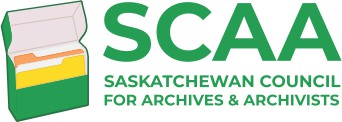Resources for Institutional Members
Manual for entry of authority records and descriptions
This is an introduction to the preparation of descriptions and the creation of authority records for entry into MemorySask.
This document is reviewed constantly. Any questions or edits can be sent to the Archives Advisor.
Manual for MemorySask (pdf download)
Basic RAD
This is an introduction to the preparation of fonds- and series-level descriptions using the Rules for Archival Description.
by Jeff O'Brien
SCA Outreach Archivist
October, 1997
As of April 2023 the on-line version was discontinued, however is still available through the Internet Archive's Wayback Machine here.
The current full Rules for Archival Description
This full version (700 pages) is available from the Canadian Council of Archives (CCA):
The individual Chapters of RAD are also available here:
- Chapter 1: General Rules for Description
- Chapter 2: Rules for Description of Units Containing Multiple Media
- Chapter 3: Textual Records
- Chapter 4: Graphic Materials
- Chapter 5: Cartographic Materials
- Chapter 6: Architectural and Technical Drawings
- Chapter 7: Moving Images
- Chapter 8: Sound Recordings
- Chapter 9: Records in Electronic Form
- Chapter 10: Records on Micro-form
- Chapter 11: Objects
- Chapter 12: Philatelic Records
- Chapter 13: Discrete Items
RAD Physical Description Builder - University of Northern BC
https://search.nbca.unbc.ca/atom_tools/rad_form.html
Subject Headings:
- First Nations, Metis and Inuit - Indigenous Ontologies (FNMIIO)
- Indigenous Subject Headings Modification Project (20 minute video)
- Provincal Archives of Alberta Subject Headings May 2020 update (PAASH)
- RAD: Part II
If an SCAA institutional member feels any additional heading should be added that does not fit in any of the above please email the SCAA Advisor
Basic Genre Terms
Basic Genre Terms for Cultural Heritage Material from the Library of Congress
If an SCAA institutional member feels any additional heading should be added that does not fit in any of the above please email the SCAA Advisor
MemorySask - SAIN recent history
On October 1 of 2020 SCAA and the U of S announced the launch of the new MemorySask - SAIN database. Searches of the full shared content of SCAA member institutions can be made in one place, including the ability to search within different photograph collections making MemorySask - SAIN a powerful tool for research.
As part of the SCAA's mission to promote the use of Archives, we have maintained the Saskatchewan Archival Information Network (SAIN) with the help of the University of Saskatchewan. SAIN initially was established in 2000 and has gone through many transformations since. It is a network of information about archival holdings in Saskatchewan and consisted of two databases, one containing descriptions of archival collections and the other descriptions and digital scans of photographs in our members' collections.
One of the most significant transformations was the deployment of the software platform "Access to Memory" or AtoM. This piece of software is open-source, developed by Artefactual Systems in British Columbia, and has been implemented by most provinces and territories. AtoM allows our members to directly enter their descriptions into the database, with minimal help of SCAA staff. The ability to handle all the differing levels in archival description with the AtoM software made it possible to merge SCAA's two SAIN databases into one.
In late 2019, U of S, with funding and staff support from SCAA, contracted Artefactual Systems to merge the two databases. This was a major undertaking involving both custom programming and manual review of descriptions. The work on the SAIN merger project was completed in March 2020. At that time several contributing institutions were able to add and update entries through a temporary hosting arrangement. This arrangement was facilitated by U of S, which hosts the public database, to minimize further downtime as their IT staff were focused on support required due to the pandemic.
With the U of S able to take-on the hosting duties from Artefactual the public launch was able to take place in October, 2020. Research and searches of the full content of both databases at once are now possible, including the ability to search within different photograph collections making MemorySask - SAIN a powerful tool for research.
MemorySask is an ever growing database as archives in Saskatchewan add more and more content and information about the history of the province.
AtoM is being used nationally for many of the provincial archival groups;
British Columbia, https://www.memorybc.ca/; Alberta, https://albertaonrecord.ca/; Manitoba, https://main.lib.umanitoba.ca/; Ontario, https://www.archeion.ca/; New Brunswick, https://search.canbarchives.ca/; Nova Scotia, https://memoryns.ca/; Prince Edward Island, http://www.archives.pe.ca/atom/; Newfoundland, https://arc.anla.nf.ca/.




